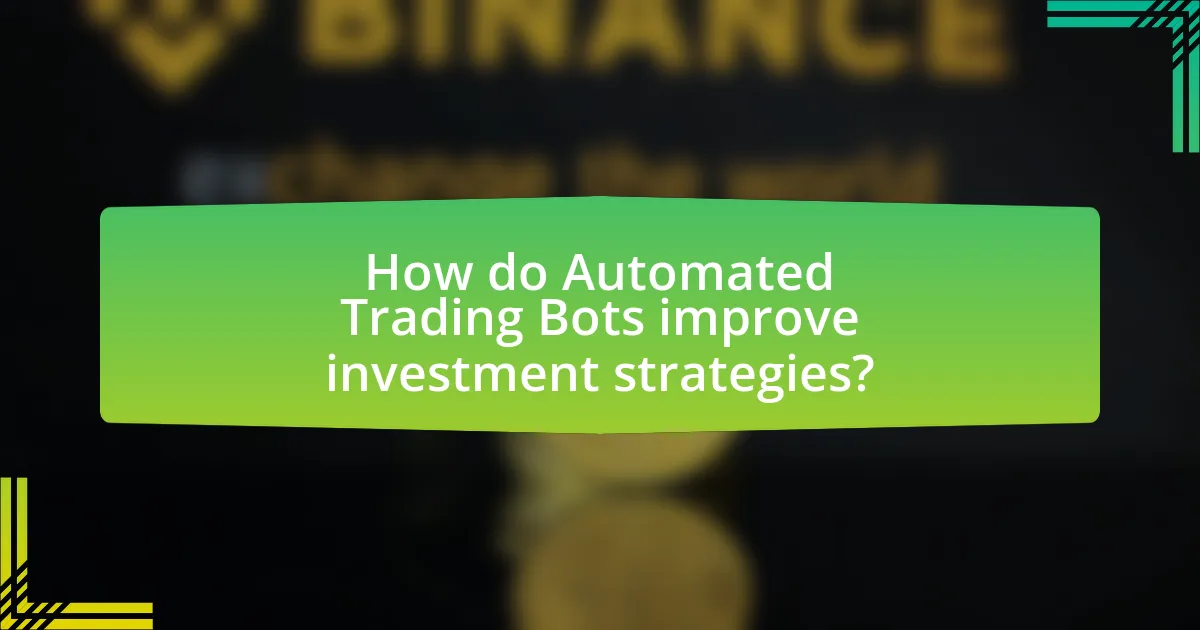Automated trading bots are software programs designed to execute trades in cryptocurrency markets based on predefined algorithms and market conditions. This article explores the functionality of these bots, including their ability to analyze market data, implement various trading strategies, and operate continuously without human intervention. Key advantages of using automated trading bots include increased trading efficiency, reduced emotional decision-making, and enhanced risk management. Additionally, the article addresses potential risks and challenges associated with automated trading, such as market volatility and technical failures, while providing best practices for investors to optimize their trading strategies and monitor bot performance effectively.

What are Automated Trading Bots in Crypto Investment Strategies?
Automated trading bots in crypto investment strategies are software programs that execute trades on behalf of investors based on predefined algorithms and market conditions. These bots analyze market data, identify trading opportunities, and execute buy or sell orders without human intervention, allowing for faster and more efficient trading. According to a report by Research and Markets, the global automated trading market is expected to grow significantly, indicating the increasing reliance on such technologies in financial markets, including cryptocurrencies.
How do Automated Trading Bots function in the crypto market?
Automated trading bots function in the crypto market by executing trades based on pre-defined algorithms and market conditions. These bots analyze market data, including price movements and trading volumes, to identify trading opportunities. They can operate 24/7, allowing them to capitalize on price fluctuations in real-time without human intervention. For instance, a study by the Cambridge Centre for Alternative Finance indicates that automated trading can enhance efficiency and reduce emotional trading errors, leading to potentially higher returns.
What algorithms do these bots use for trading decisions?
Automated trading bots use various algorithms for trading decisions, including trend-following algorithms, arbitrage algorithms, market-making algorithms, and machine learning algorithms. Trend-following algorithms analyze historical price data to identify patterns and predict future movements, while arbitrage algorithms exploit price discrepancies across different exchanges. Market-making algorithms provide liquidity by placing buy and sell orders, and machine learning algorithms adapt to market changes by learning from vast datasets. These algorithms enhance trading efficiency and decision-making speed, allowing bots to execute trades based on real-time data and predefined strategies.
How do trading bots analyze market data?
Trading bots analyze market data by utilizing algorithms that process vast amounts of information in real-time to identify patterns and trends. These algorithms often incorporate technical indicators, such as moving averages and relative strength index, to make informed trading decisions. For instance, a trading bot may analyze historical price data and volume to predict future price movements, allowing it to execute trades automatically based on predefined criteria. This method of analysis enables trading bots to react quickly to market changes, enhancing their effectiveness in executing trades compared to human traders who may be slower to respond.
What advantages do Automated Trading Bots provide to investors?
Automated trading bots provide investors with several advantages, including increased efficiency, reduced emotional trading, and the ability to execute trades 24/7. These bots can analyze market data and execute trades at speeds unattainable by human traders, allowing for timely responses to market fluctuations. Additionally, by removing emotional decision-making, automated trading bots help investors adhere to their trading strategies consistently, which can lead to improved performance. According to a study by the Journal of Financial Markets, algorithmic trading can enhance market liquidity and reduce transaction costs, further benefiting investors.
How do these bots enhance trading efficiency?
Automated trading bots enhance trading efficiency by executing trades at optimal times based on pre-defined algorithms and market analysis. These bots analyze vast amounts of market data in real-time, allowing them to identify profitable trading opportunities faster than human traders. For instance, a study by the CFA Institute found that algorithmic trading can reduce transaction costs by up to 20% due to improved execution speed and accuracy. Additionally, bots can operate 24/7, ensuring that trades are executed even when human traders are unavailable, further maximizing potential profits and minimizing losses.
What role do trading bots play in risk management?
Trading bots play a crucial role in risk management by automating trading strategies that minimize potential losses and optimize profit opportunities. These bots utilize algorithms to analyze market data, execute trades at optimal times, and implement stop-loss orders, which help limit losses in volatile markets. For instance, a study by the Journal of Financial Markets found that automated trading systems can reduce emotional decision-making, leading to more disciplined trading practices and improved risk-adjusted returns. By continuously monitoring market conditions and adjusting strategies accordingly, trading bots enhance the ability to manage risk effectively in crypto investment strategies.

How do Automated Trading Bots improve investment strategies?
Automated trading bots improve investment strategies by executing trades based on predefined algorithms and market conditions, which enhances efficiency and reduces emotional decision-making. These bots analyze vast amounts of market data in real-time, allowing for rapid execution of trades that capitalize on price fluctuations. For instance, a study by the CFA Institute found that algorithmic trading can increase market liquidity and reduce transaction costs, leading to better overall investment performance. Additionally, automated trading bots can operate 24/7, ensuring that investment opportunities are not missed, which is particularly beneficial in the volatile cryptocurrency market.
What specific strategies can be implemented using trading bots?
Trading bots can implement several specific strategies, including arbitrage, market making, trend following, and mean reversion. Arbitrage strategies exploit price differences across different exchanges to generate profit, while market making involves placing buy and sell orders to profit from the spread. Trend following strategies analyze market momentum to identify and capitalize on upward or downward trends, and mean reversion strategies assume that asset prices will revert to their historical averages. These strategies are supported by data showing that automated trading can increase efficiency and reduce human error, leading to more consistent trading outcomes.
How do bots execute high-frequency trading strategies?
Bots execute high-frequency trading strategies by utilizing algorithms to analyze market data and execute trades at extremely high speeds. These algorithms can process vast amounts of information, including price movements and trading volumes, allowing bots to identify and capitalize on short-term market inefficiencies. For instance, a study by the CFA Institute found that high-frequency trading accounts for over 50% of all equity trading volume in the U.S., demonstrating the significant impact and efficiency of these automated systems in real-time trading environments.
What is the significance of arbitrage in automated trading?
Arbitrage is significant in automated trading as it allows traders to exploit price discrepancies across different markets or exchanges instantly. Automated trading systems can execute arbitrage strategies at high speeds, capitalizing on fleeting opportunities that manual traders may miss. For instance, if Bitcoin is priced at $30,000 on one exchange and $30,200 on another, an automated trading bot can buy Bitcoin on the cheaper exchange and sell it on the more expensive one, securing a profit. This efficiency not only enhances profitability for traders but also contributes to market efficiency by aligning prices across platforms.
Why should investors consider using Automated Trading Bots?
Investors should consider using Automated Trading Bots because they enhance trading efficiency and can execute trades at optimal times without human emotional interference. These bots utilize algorithms to analyze market data and make decisions based on predefined criteria, allowing for faster execution than manual trading. For instance, a study by the Financial Times indicated that automated trading can increase trading speed by up to 10 times compared to traditional methods, leading to better price execution and reduced slippage. Additionally, automated trading can operate 24/7, capturing opportunities in the market that may arise outside of regular trading hours, thus maximizing potential returns.
What are the potential returns on investment with trading bots?
The potential returns on investment with trading bots can vary significantly, often ranging from 5% to over 100% annually, depending on market conditions and the strategies employed. Trading bots utilize algorithms to analyze market data and execute trades at high speeds, which can capitalize on small price movements that human traders might miss. For instance, a study by the University of Cambridge found that automated trading systems can outperform traditional trading methods by leveraging data analysis and executing trades more efficiently. Additionally, a report from the Financial Times indicated that hedge funds using algorithmic trading strategies achieved an average return of 10% to 15% higher than their non-algorithmic counterparts over a five-year period.
How do bots help in maintaining emotional discipline in trading?
Automated trading bots help maintain emotional discipline in trading by executing trades based on pre-defined algorithms without human emotional interference. These bots operate on set parameters, ensuring that decisions are made based on data and strategy rather than fear or greed, which are common emotional pitfalls in trading. For instance, a study by the CFA Institute found that emotional decision-making can lead to significant losses, while algorithmic trading can reduce such risks by adhering strictly to trading rules. This reliance on automation allows traders to stick to their strategies consistently, minimizing impulsive actions that can arise from market volatility.

What challenges and considerations are associated with Automated Trading Bots?
Automated trading bots face several challenges and considerations, including market volatility, technical failures, and regulatory compliance. Market volatility can lead to unexpected losses, as bots may execute trades based on historical data that does not account for sudden price changes. Technical failures, such as software bugs or connectivity issues, can disrupt trading operations, resulting in missed opportunities or financial losses. Additionally, regulatory compliance is crucial, as different jurisdictions have varying rules regarding automated trading, and failure to adhere to these regulations can lead to legal repercussions. These factors highlight the importance of thorough testing, continuous monitoring, and adherence to legal standards when deploying automated trading bots.
What risks do investors face when using trading bots?
Investors face several risks when using trading bots, including market volatility, technical failures, and lack of regulatory oversight. Market volatility can lead to significant losses if a bot executes trades based on outdated or incorrect algorithms. Technical failures, such as software bugs or connectivity issues, can result in missed opportunities or unintended trades. Additionally, the lack of regulatory oversight in the trading bot industry means that investors may encounter scams or poorly designed bots that do not perform as promised. These risks highlight the importance of thorough research and risk management when utilizing automated trading solutions.
How can technical failures impact trading outcomes?
Technical failures can significantly disrupt trading outcomes by causing delays, erroneous transactions, or complete system outages. For instance, a malfunction in an automated trading bot can lead to missed opportunities or unintended trades, resulting in financial losses. Historical data shows that in 2012, a technical glitch at Knight Capital Group led to a loss of $440 million in just 45 minutes due to erroneous trades, highlighting the severe impact of such failures. Additionally, during high volatility periods, like the 2020 market crash, technical failures can exacerbate losses as traders are unable to react swiftly to market changes.
What security concerns should investors be aware of?
Investors should be aware of several security concerns, including the risk of hacking, phishing attacks, and the potential for software vulnerabilities in automated trading bots. Hacking incidents have led to significant losses in the cryptocurrency market; for example, the 2014 Mt. Gox hack resulted in the loss of approximately 850,000 Bitcoins, highlighting the importance of robust security measures. Phishing attacks target investors by tricking them into revealing sensitive information, which can lead to unauthorized access to their accounts. Additionally, automated trading bots may have software vulnerabilities that can be exploited, resulting in financial losses. Therefore, investors must prioritize security protocols, such as using two-factor authentication and conducting thorough research on the trading bots they choose to utilize.
How can investors effectively choose and implement Automated Trading Bots?
Investors can effectively choose and implement Automated Trading Bots by evaluating their performance metrics, understanding their algorithms, and conducting thorough backtesting. Performance metrics such as historical returns, drawdown, and win rates provide insights into a bot’s effectiveness. Understanding the underlying algorithms helps investors assess whether the bot aligns with their trading strategies and risk tolerance. Conducting backtesting on historical data allows investors to simulate the bot’s performance under various market conditions, ensuring it can adapt to changing environments. According to a study by the CFA Institute, automated trading systems can enhance trading efficiency and reduce emotional decision-making, further validating the importance of careful selection and implementation.
What features should investors look for in a trading bot?
Investors should look for features such as algorithmic trading strategies, backtesting capabilities, risk management tools, and user-friendly interfaces in a trading bot. Algorithmic trading strategies enable the bot to execute trades based on predefined criteria, enhancing efficiency and speed. Backtesting capabilities allow investors to evaluate the bot’s performance using historical data, ensuring the strategy’s viability before real-time application. Risk management tools, including stop-loss and take-profit settings, help protect investments from significant losses. A user-friendly interface is essential for ease of use, enabling investors to navigate the bot’s functionalities without extensive technical knowledge. These features collectively contribute to a more effective and secure trading experience.
How can investors optimize their trading strategies with bots?
Investors can optimize their trading strategies with bots by utilizing algorithmic trading to execute trades based on predefined criteria, which enhances efficiency and reduces emotional decision-making. Automated trading bots analyze market data in real-time, allowing investors to capitalize on price fluctuations and trends that may be missed through manual trading. For instance, a study by the CFA Institute found that algorithmic trading can improve execution quality and reduce transaction costs by up to 30%. By implementing strategies such as arbitrage, trend following, or market making, investors can leverage bots to maximize returns while minimizing risks associated with human error.
What best practices should be followed when using Automated Trading Bots?
When using Automated Trading Bots, it is essential to implement best practices to maximize effectiveness and minimize risks. First, traders should conduct thorough backtesting of the bot’s strategies using historical data to ensure reliability and performance under various market conditions. According to a study by the CFA Institute, backtesting can reveal potential weaknesses in trading strategies, allowing for adjustments before real capital is at stake.
Second, traders must set clear risk management parameters, including stop-loss and take-profit levels, to protect their investments. Research from the Journal of Financial Markets indicates that effective risk management significantly enhances trading outcomes by limiting potential losses.
Third, continuous monitoring of the bot’s performance is crucial, as market conditions can change rapidly. A report by the Financial Conduct Authority emphasizes the importance of oversight in automated trading to identify and rectify any issues promptly.
Lastly, traders should diversify their strategies and not rely solely on one bot or approach. The diversification strategy is supported by findings from the Modern Portfolio Theory, which suggests that spreading investments across various assets can reduce risk and improve returns.
How can investors monitor and adjust bot performance over time?
Investors can monitor and adjust bot performance over time by utilizing performance metrics, backtesting results, and real-time analytics. Performance metrics such as return on investment (ROI), win/loss ratio, and drawdown provide insights into how well the bot is executing trades. Backtesting results allow investors to evaluate the bot’s effectiveness based on historical data, helping to identify any necessary adjustments in strategy. Real-time analytics enable investors to track the bot’s performance continuously, allowing for timely modifications to trading parameters or strategies based on market conditions. This systematic approach ensures that investors can optimize their automated trading bots for better outcomes in the dynamic crypto market.
What common mistakes should be avoided when using trading bots?
Common mistakes to avoid when using trading bots include neglecting proper risk management, failing to backtest strategies, and not monitoring bot performance regularly. Neglecting risk management can lead to significant losses, as traders may set high leverage without understanding the risks involved. Failing to backtest strategies means traders may deploy bots without verifying their effectiveness in historical market conditions, which can result in poor performance. Additionally, not monitoring bot performance can lead to missed opportunities for adjustments or corrections, as market conditions can change rapidly. These mistakes can undermine the potential benefits of automated trading bots in crypto investment strategies.






